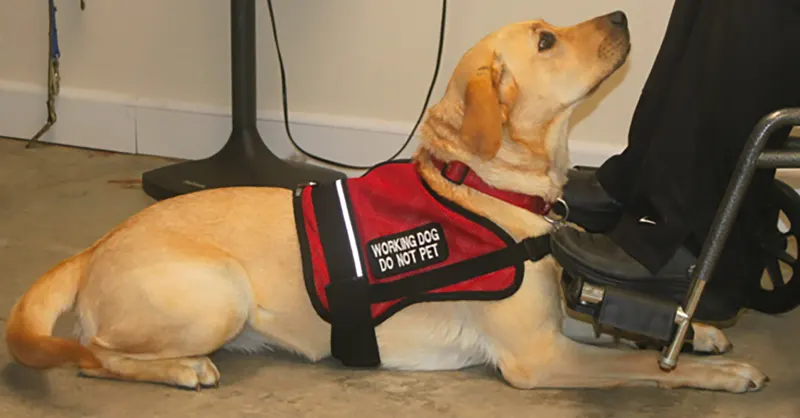Archive for the ‘Dogs’ Category
For those wondering what disabilities qualify for individual assistance animals, it can be hard to determine which kind would offer the best in terms of service and companionship. Service animals and emotional support animals can get confusing from time to time. Here is a basic outline of what the similarities and differences are between service dogs and emotional support animals to help you determine what kind of animal you qualify for:
Service Animals: Service animals can be dogs or miniature horses and must be trained to provide a task for their disabled owners. Dogs (and miniature horses) only – Under the American Disabilities Act, only dogs can be eligible as service animals. These animals are legally recognized under government policies as having specific rights and qualifications in comparison to other animals due to their ability to be trained in particular tasks and handle a person’s disability. Miniature horses also have recognition under the ADA but have other provisions regarding them. Have advanced levels of training specific to a person’s disability – Service dogs are trained in tasks related to a person’s disability, as well as house training and other jobs. For instance, guide dogs, a type of service dog, must be trained to help assist a disabled person who is blind or visually impaired. Have nationally recognized certification programs – Organizations such as Assistance Dogs International have certification and training programs for service animals. The ADA requires that service animals be trained to help serve their disabled owners. Have access to public spaces – The ADA allows service animals to have access to public spaces. Business owners, managers, and staff have limited access to the questions they can ask in regards to service animals and their disabled owners. Emotional Support Animals: Can range in a wide variety of animals – Animals such as dogs, cats, rabbits, and guinea pigs can all qualify as emotional support animals. ESAs are considered to be “owned pets,” unlike service animals. While there are no limits to what an ESA can be, it’s essential to take into account the state legislature and their definitions of what ESAs are. ESAs are not specially trained to perform tasks – As of current, there is no national legislation regulating the training that qualifies ESAs. Although numerous organizations can help train ESAs, ESAs are not federally recognized as a kind of service animal. Although coined under the terms assistance animals or companion animals, training ESAs are considered optional, but recommended. Do not have access to public spaces – ESAs operate under different legislation and are protected under the Fair Housing Act. Hence, ESAs have limited access to public spaces. Require a licensed professional to be considered an ESA – Pets/animals can only be considered ESAs if they have an ESA letter written and approved by a mental health licensed professional, including therapists, counselors, psychiatrists, and psychologists. By having an ESA letter, ESAs can gain access to housing despite no-pets policies and at no extra cost.Both provide assistance related to a person’s disability, but how they perform those services differ from another. They both are not required to be trained professionally, as each owner can self-train their animals to serve specific tasks.
Is an emotional support animal for you? See if you qualify. Get your ESA in three easy steps. Legal protections for a service dog Service dogs are protected under the ADA and can go wherever their owners go.The Department of Justice published the Americans with Disabilities Act to show the requirements related to service dogs. By providing regulations about service dogs, the ADA can help clarify issues related to service dogs. The ADA has legal protections outlined for public awareness, aiming at educating people the regulations involved with service animals, which include:
Staff may ask only two specific questions in regards to service dogs: Is the dog a service animal required because of a disability? And what work or task has the dog been trained to perform? Staff is thus not allowed to request any documentation for the dog, require demonstrations of the dog’s abilities, or inquire about the nature of the person’s disability. For businesses that serve the public goods and services, the ADA does not require those entities to modify policies if it would “fundamentally alter” the nature of those services provided to the public. This would be considered an exception for staff to prohibit a service animal if the animal alters those services. Service dogs may be excluded if the handler cannot control the animal. Controlling the animal refers to the service dog being under the handler’s control at all times. The animal must be leashed, harnessed or tethered while in public places unless it interferes with the service animal’s ability to perform its tasks. If those methods of control interfere, the handler must use voice, signal or other means to control the animal.These are a few examples of the protections that service dogs have for the public. These service animals have legal protections as long as the handler has control and adequate training in place for the animal so it can perform its duties for the disabled owner.
Legal protections for Emotional Support Animals Emotional support animals are protected by the Fair Housing Act.While ESAs don’t have specific protections under the ADA, there are other federal legislations that help clarify the definitions of ESAs and their rights within those limited spaces.
Emotional support animals have specifical protections and protocols, according to the Department of Housing’s Fair Housing Act of 1988. Under the Fair Housing Act, ESAs are categorized under the term assistance animals, which the FHA defines them as animals that work, provide assistance and perform tasks for a person with a disability, or provides emotional support alleviating one or more symptoms of a person’s disability. Landlords must modify their policies to permit a person with a disability to live with a service animal or emotional support animal. For those with ESAs, the applicant for housing may need to submit medical documentation, such as an ESA letter, showing the animal provides support and mitigates one symptom of that person’s disability.
Which disabilities qualify for a service dog?The Americans with Disabilities Act defines a person with a disability as individuals with a physical or mental impairment that significantly limits one or more major life activities. These disabilities can range from physical to psychological, but the person must be regarded as an impairment and have a record of that impairment. Physical or mental disabilities can include diseases, visual, speech, and hearing impairments, psychological conditions such as cerebral palsy, autism, epilepsy, mental retardation, and health conditions such as cancer, heart disease, diabetes, drug addiction, and alcoholism. If the impairment limits activities central to everyday life, such as eating, speaking, walking, and performing manual tasks, then the person can qualify as disabled under the ADA and thus qualify for a service dog.
Which disabilities qualify for an ESA?Emotional support animals perform disability-related functions focusing on providing emotional support, aiding in mental disabilities such as depression, anxiety, PTSD, and bipolar disorder. ESA’s focus more on mental and emotional disabilities than physical. While the Fair Housing Act combines emotional support animals under the term assistance animals, a person with a disability who has an ESA must be able to show a tenant that they have a mental impairment, show a record of that mental impairment, and be regarded as disabled due to this impairment. (HUD).
Depending on the type of disability you have, both service dogs and emotional support animals offer benefits and different areas of specialties. If you desire a service animal or emotional support animal, speak with your health professional about your options and discuss with them what opportunities will serve you best.
Service dogs for mental health, known as psychiatric service dogs (PSD), can help certain people with post-traumatic stress disorder (PTSD). A PTSD service dog can legally accompany their handler in areas open to the public, residential buildings that ban pets, and on airplanes.
In this article, we will explain how a service dog can assist with PTSD symptoms and the requirements to own one.
Qualifying for a PTSD Service DogPost-traumatic stress disorder can be considered a disability under the Americans with Disabilities Act (ADA) in some circumstances. PTSD arises from witnessing or experiencing traumatic events, leading to symptoms such as flashbacks, nightmares, severe anxiety, and uncontrollable thoughts related to the trauma.
If these symptoms significantly interfere with major life activities, the individual with PTSD may be eligible for ADA protections and accommodations, including using a service dog.
Unsure whether your condition qualifies? Talk to your licensed healthcare provider and see if you can obtain a PSD letter from them.
The Role of a Service Dog in PTSD ManagementA service dog is individually trained to perform tasks that alleviate their handler’s condition. This also distinguishes them from emotional support animals (ESA), which provide comfort through their presence but require no specialized training.
ESAs help people with PTSD just by being present and without rigorous training. Qualifying for an emotional support animal requires getting an ESA letter.
A PTSD service dog offers myriad benefits to their handler. Some key tasks for PTSD service dogs include:
Interrupting nightmares and flashbacks by recognizing signs of distress and waking the handler. Offering comfort during panic attacks and guiding handlers to quieter, less crowded spaces. Creating a buffer in crowds to reduce anxiety. Interrupting self-harming behaviors. Grounding individuals, reducing feelings of overwhelm or disorientation, and providing a sense of security.Since PTSD service dogs are allowed in public venues normally closed off to pets, they should also be trained to be comfortable in these environments. A service dog must be under the control of its handler at all times and able to focus on the needs of its handler.
A service dog can be any breed. You can either train your own service dog or work with an accredited trainer. PTSD Service Dog RightsService dogs for PTSD are granted specific rights under the Americans with Disabilities Act, Air Carrier Access Act (ACAA), and Fair Housing Act (FHA). Under the ADA, PTSD service dogs are allowed access to public places where other dogs may be prohibited, such as restaurants, stores, and hotels.
In terms of travel, the ACAA permits PTSD service dogs to accompany their handlers in the cabin of an aircraft at no extra charge. Lastly, under the FHA, individuals with disabilities cannot be denied housing or charged extra fees because they have a service dog, even in pet-free housing.
These rights ensure that individuals with PTSD can navigate public spaces, travel, and secure housing with their service dogs, providing vital assistance and support.
ConclusionTo sum up, individuals with Post-Traumatic Stress Disorder (PTSD) can significantly benefit from the assistance of service dogs. These specially trained canines provide essential support, from interrupting distressing nightmares to offering a sense of security during panic attacks.
While owning a service dog is a considerable responsibility, for those grappling with PTSD the companionship and assistance they offer can be transformative. If you’re unsure whether you have an eligible condition, consult a mental health professional to see if you can obtain a PSD letter. They can guide you in making this important decision, ensuring it aligns with your unique needs and lifestyle.
Alert dogs are best known for guiding the visually impaired, sniffing out drugs and bombs, or providing mobility assistance for people with severe disabilities. Diabetic Service Dogs, or DSDs for short, are service dogs trained to detect hypoglycemia and alert their owners to treat it while they are still conscious and aware. The ADA, or the American Disability Association, considers this to be a type of service dog because diabetes is a type of disability. DSDs detect low blood sugar through organic compounds in the person’s breath and are trained to respond to these changes in blood sugar. Whether the individual has Type I, Type II, or hypoglycemia unawareness, DSDs can react to these changes in compounds and alert the owner to act.
What services do Diabetic Service Dogs provide?While the primary objective of a DSD is to notify their owner of any changes to their blood sugar levels, they also provide other ways of service that come with a service animal, such as:
A Sense of Comfort for the Owner Increased Physical Activity Improved Regulation of Blood Sugar Levels Increased Socialization and Independence A Sense of Ease for Family MembersDSDs can also be used as a medical expense. As long as the owner’s disability is legally recognized, the costs of buying, training and maintaining the owner’s service dog can count towards their tax assessments. While DSDs provide companionship, DSDs cannot be the only reliable source for people to check their blood sugar. Owners of DSDs should not rely entirely on their service animals and should check their glucose monitors for their levels and take extra precaution when dealing with their health.
Diabetic Service Dogs can notify their owners when blood sugar levels change. How do trainers train a Diabetic Service Dog?Training varies depending on the organization or trainer. Diabetic Service Dogs are trained from birth until they are around 18 months old, beginning with training in public access and social conditioning to help to expose them to various environments, including scents, objects, and sounds. From there, trainers work the dogs towards the next step, scent detection work. In the case for DSDs, these dogs are trained to detect the hypoglycemic scent, obtained from a person with diabetes while their blood sugar level is below 70. These dogs are then tested under the Assistance Dogs International (ADI) public access test, which follows through a series of objectives to evaluate the dog’s behavior in distracting environments. For owners who wish to train their dogs, they should partner with a trainer experienced in training service dogs and follows the ADA guidelines.
How accurate are Diabetic Service Dogs at detecting low blood sugar?Dogs are known to have a great ability to smell. This ability to detect smell is based on the number of olfactory cells they have. Compared to humans, who have 5 million olfactory cells, dogs have up to 220 million olfactory cells. This means that a dogs nose can be 1,000 times more sensitive than a human. In practice, DSDs alert their owners by recognizing a scent emitted when that diabetics blood sugar begins to drop rapidly. However, the accuracy of the dog’s ability to smell that scent or what precisely the smell is is up to debate by many researchers. According to studies, results vary, with some stating that the dog’s ability isn’t as accurate and others stating the opposite. Hence, the standards for what accounts as a precise sense of smell for DSDs is currently unavailable and is still being determined.
How to register your Diabetic Service DogBecause the ADA does not directly support service dog registration, it is essential to find the right organization to register your service dog. The right Service Dog Certifications and Registry will provide support for service dog owners. By ordering a custom identification card for you and your Service Dog, you help others follow the guidelines set out by the ADA and helps store employees grant public access to you even if they have a no-pet policy. It is important to work with a trustworthy source so you can direct store employees to the right resource as well. Service Dog Certifications, however, does not train or provide assistance dogs for people with disabilities. Instead, they recommend adopting a service dog and working with a trainer if you have the means. If that is not possible, no worries, you can absolutely still adopt a service dog and train them yourself or seek support from a local trainer.
Some tips on choosing the right organization/trainer include:
Don’t get a dog from a trainer or organization that will not allow you to visit the training facility Ask the trainer about follow-up support Ask for test demonstrations for the puppy as you would with an adult dog Ask for health records, demand to see the kennel and parents of the pup. Ask about scent imprint procedures and exactly how the trainers teach their dogs to imprint. After purchasing your new DSD, get a health evaluation from your vet: Hip x-ray, routine blood tests, heartworm snap.






